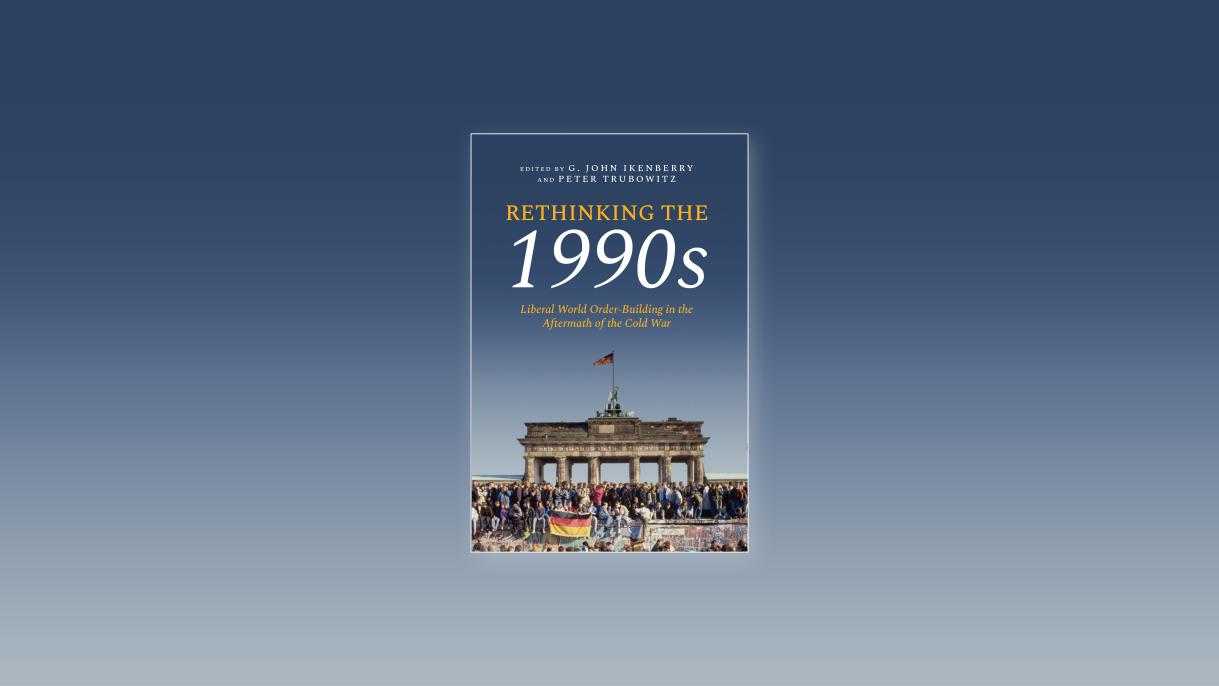

New Book Takes a Fresh Look at the Nineties and Its Impacts Today
With the fall of the Berlin Wall in November 1989, the reunification of Germany a year later, and the collapse of the Soviet Union a year after that, the 1990s were shaping up as a hopeful time for the West. Liberal democracy appeared to be ascendent, free trade was championed, and the catastrophic tragedies of two world wars and the Cold War were things of the past.
That optimism now looks misplaced. Three decades later, global conflicts – one of them involving Russia’s invasion of a former Soviet Socialist Republic – continue, economic nationalism is on the rise, and ideological extremism grips numerous countries.
So what happened?
A newly published collection of essays attempts to answer that question. “Rethinking the 1990s: Liberal World Order-Building in the Aftermath of the Cold War” (Oxford University Press), co-edited by G. John Ikenberry, the Albert G. Milbank Professor of Politics and International Affairs at the Princeton School of Public and International Affairs, brings together leading political scientists and historians to explore the decisions and trends that have led to the world to its current fraught moment – and what could have been done differently.
Topics include the West’s engagement with China, U.S. relations with Europe and Japan, the financialization of the American economy, NATO expansion, Russia, and more. Princeton SPIA faculty member Harold James, the Claude and Lore Kelly Professor in European Studies and a professor of history and international affairs, contributed a chapter titled “The Return of/to Europe and the New Politics of Globalism.”
Ikenberry, a co-director of the School’s Center for International Security Studies, co-wrote the book’s first essay, “Making Sense of the 1990s: Choices, Pathways, and Missed Opportunities.” An excerpt follows:
The 1990s also witnessed a surge in the pace of democratization globally. Spurred by the velvet revolutions in the former Soviet bloc between 1989 and 1991, a growing number of countries in Africa and Central Asia expanded rights to political participation and to freer political exchange. The surge of political liberalization in the 1990s eclipsed earlier democratic waves in the twentieth century, including the postwar boom and the democratic wave of the 1960s, 1970s, and 1980s in Africa, Latin America, the Asia-Pacific, and South Asia. At a time when the number of sovereign states was increasing rapidly, the end of the Cold War created opportunities and incentives to democratize by weakening the ties that many military and one-party dictatorships previously enjoyed with one of the superpowers. Of course, political liberalization did not spread everywhere—the Middle East and North Africa lagged behind. Some countries only partially democratized, while others did become more democratic, only to reverse course. Even before the 1990s were out, autocracy was gaining ground.
If the 1990s were a decade of achievements, they were also a time of missed opportunities. As the chapters show, Washington and other Western capitals often misjudged developments, squandered opportunities, and overestimated support. Several of the chapters argue that the Western democracies entered and exited the 1990s brimming with overconfidence in the power of liberal political and economic ideas. Great hopes were pinned on the promise of a more open, integrated, neoliberal world order and America’s capacity to consolidate, protect, and extend democracy and markets across the globe. The “liberal bet” on China also failed: as China got rich, it did not become a more open, democratic, and status-quo power. A wide debate continues over whether a better relationship between Russia and the West could have been salvaged from the ashes of the Cold War and whether the seeds of Vladimir Putin’s war on Ukraine were sown in decisions by America and its European allies to expand NATO and the European Union eastward. Meanwhile, antiglobalist opposition to this more expansive liberal international agenda took root and spread within the Western democracies themselves.
The sequence of steps and missteps—by Western and non-Western states—were many and are scattered across the past thirty years. Perhaps the most consequential international missteps manifested long after the 1990s. The failure to find a way to reform the United Nations, expand cooperation with the Global South, and build new capacities to confront climate change, health pandemics, and nuclear proliferation also led to questions about whether all the post–Cold War opportunities for building new forms of cooperation were fully seized. In these various ways, the “victory” in the Cold War led to reassessments of the trajectories of modernity in the 1990s that turned out to be incorrect. The expansion of the liberal order after the Cold War also had the ironic effect of planting the seeds for later conflicts and eroding the liberal order’s international and domestic foundations in ways that are now too obvious to ignore or wish away. We must also factor these longer-term effects into any assessment of the 1990s and its impact on world politics.

